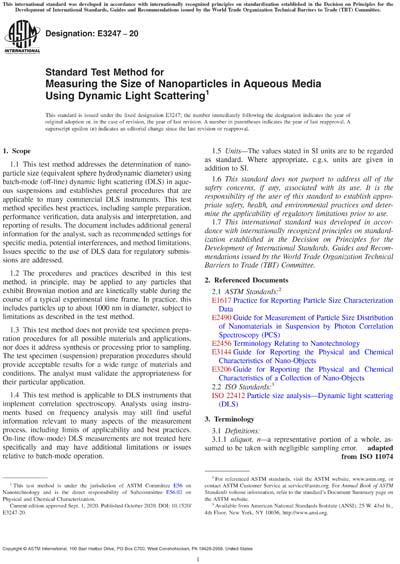Most recent
ASTM E3247-20
Standard Test Method for Measuring the Size of Nanoparticles in Aqueous Media Using Dynamic Light Scattering
1.1 This test method addresses the determination of nanoparticle size (equivalent sphere hydrodynamic diameter) using batch-mode (off-line) dynamic light scattering (DLS) in aqueous suspensions and establishes general procedures that are applicable to many commercial DLS instruments. This test method specifies best practices, including sample preparation, performance verification, data analysis and interpretation, and reporting of results. The document includes additional general information for the analyst, such as recommended settings for specific media, potential interferences, and method limitations. Issues specific to the use of DLS data for regulatory submissions are addressed.
1.2 The procedures and practices described in this test method, in principle, may be applied to any particles that exhibit Brownian motion and are kinetically stable during the course of a typical experimental time frame. In practice, this includes particles up to about 1000 nm in diameter, subject to limitations as described in the test method.
1.3 This test method does not provide test specimen preparation procedures for all possible materials and applications, nor does it address synthesis or processing prior to sampling. The test specimen (suspension) preparation procedures should provide acceptable results for a wide range of materials and conditions. The analyst must validate the appropriateness for their particular application.
1.4 This test method is applicable to DLS instruments that implement correlation spectroscopy. Analysts using instruments based on frequency analysis may still find useful information relevant to many aspects of the measurement process, including limits of applicability and best practices. On-line (flow-mode) DLS measurements are not treated here specifically and may have additional limitations or issues relative to batch-mode operation.
1.5 Units—The values stated in SI units are to be regarded as standard. Where appropriate, c.g.s. units are given in addition to SI.
1.6 This standard does not purport to address all of the safety concerns, if any, associated with its use. It is the responsibility of the user of this standard to establish appropriate safety, health, and environmental practices and determine the applicability of regulatory limitations prior to use.
1.7 This international standard was developed in accordance with internationally recognized principles on standardization established in the Decision on Principles for the Development of International Standards, Guides and Recommendations issued by the World Trade Organization Technical Barriers to Trade (TBT) Committee.
ASTM International [astm]

